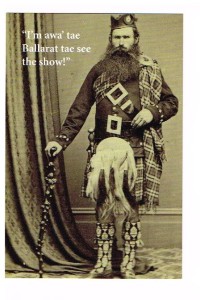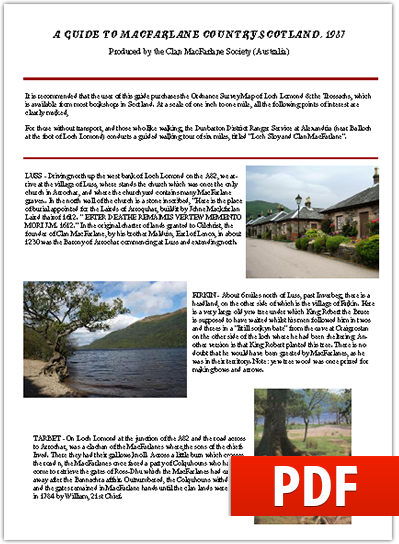“I’m awa’ tae Ballarat tae see the show!”
 We had a great day out in Ballarat yesterday despite the blustery weather conditions. As the rain pelted down outside, my husband and I tucked into a light lunch at the Art Gallery Cafe in Ballarat before visiting the “For Auld Lang Syne” exhibition which is due to close on 27th July.
We had a great day out in Ballarat yesterday despite the blustery weather conditions. As the rain pelted down outside, my husband and I tucked into a light lunch at the Art Gallery Cafe in Ballarat before visiting the “For Auld Lang Syne” exhibition which is due to close on 27th July.
This is a magnificent collection of artwork and objects illustrating the significant contribution that Scots have made to Australia. The items on display are too numerous to list but some that caught my eye were:
- A watercolour painted in 1878 depicting the Hall at Werribee Park, owned by the Chirnside brothers, sons of a Berwickshire farmer.
- An oil painting on canvas of the Marco Polo, a well known emigrant ship of the 1850s.
- A portrait of the Rev. John Dunmore Lang, Presbyterian clergyman and tireless promoter of emigration. (Here it was noted that on his death he was so highly respected that the funeral procession was a mile long!)
- Some of the earliest policitical prisoners sent to New South Wales were the celebrated five radicals known as The Scottish Martyrs. Only two of them were Scottish by birth: Thomas Muir and William Skirving. Whilst they are commemorated by a 94ft obelisk at the Old Calton Cemetery in Edinburgh, erected in 1844, the exhibition in Ballarat had another memento from the time of their sentencing in the 1790s, a linen scarf.
- There were two grandiose portraits of Captain John Piper, and his wife and children. Apparently Captain Piper was a disgraced Collector of Customs (1826) who relished the high life. He is said to have been an early exponent of Scottish nostalgia and the romantic idea of Highland life.
- Charles Bruce was a Scottish born convict engraver who produced an engraving titled “Hobart Town Chain Gang” c. 1831. This depicted convict prisoners in Hobart. The description on this exhibit said that Scottish judges were reluctant to impose a harsh sentence for minor crimes and therefore only about 5% of the male convict population in Australia was Scottish.
- There was also an example of Scrimshaw. This was a bone from a sea mammal (such as a whale) which had been carved with the image of a Highlander and then the carving had been highlighted with pigment.
The only exhibit that I saw that displayed the word MACFARLANE (which naturally caught my eye) was an 1874 photo engraving on paper titled “John Forrest’s Party (his brother Alexander, second in command) sight the overland telegraph line.” This was painted by J. Macfarlane (1890-1898) and is part of a collection of pictures of Australian explorers held in the Pictures Collection in the National Library of Australia.
Did you know that many Scottish companies founded in the 19th century in Australia are still flourishing today? These include:
– Arnotts Biscuits
– Boag’s Beer
– Bendigo Pottery
– MacRobertson’s Chocolates
– Selkirk Bricks
– Waverley Woollen Mills
The exhibition was complete with tartan feature walls, and mounted stag heads (the latter apparently on loan from a local private collection).
Guided tours of For Auld Lang Syne are also available each day at 11.30am and 1.30pm, exclusively for ticket holders, departing from the ticket desk at the entrance to the exhibition.
There is also a well illustrated hardcover book “For Auld Lang Syne” available for sale in the bookshop ($75).
You may also be interested in reading other reviews on the internet:
http://www.abc.net.au/local/photos/2014/04/10/3982532.htm
http://theconversation.com/for-auld-lang-syne-in-ballarat-reviewing-an-old-acquaintance-26746


Another well-written article! Keep up the good work!